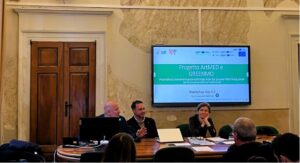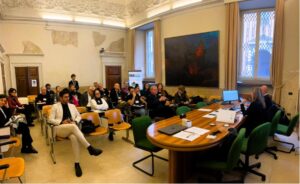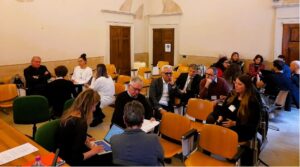 On Tuesday, December 10, 2024, the participatory workshop, which was organized as part of the GREENMO project, took place at the Headquarters of the Province of Mantua in Italy. The event brought together local citizens, representatives of the citizen organizations, and representatives of tourist associations to co-design innovative solutions for sustainable mobility.
On Tuesday, December 10, 2024, the participatory workshop, which was organized as part of the GREENMO project, took place at the Headquarters of the Province of Mantua in Italy. The event brought together local citizens, representatives of the citizen organizations, and representatives of tourist associations to co-design innovative solutions for sustainable mobility.
The primary activity was an interactive workshop. Participants were divided into three working groups, each of which focused on a specific context: urban, peri-urban, and rural mobility hubs. The aim was that they could collaborate and jointly identify local needs and propose models for mobility hubs that integrate various transportation modes.

In the group dedicated to urban hubs, discussions centered on integrating shared mobility with public transportation. Solutions aimed at improving accessibility and optimizing existing resources emerged. The group which was focused on peri-urban areas addressed the challenges of connecting peripheral regions with central ones, proposing flexible hubs that adapt to the needs of commuters and residents. Finally, the rural hub group emphasized the importance of designing infrastructures that address the specific characteristics of low-density areas, ensuring equitable access to mobility services.
Thus, the participatory approach was the heart of the event, enabling the collection of a wide range of perspectives and innovative ideas. From the insights gathered during the workshop, some key challenges highlighted included:
- Integration Across Contexts:
- In urban areas, ensuring seamless integration between shared mobility services and public transport systems was a primary concern, requiring robust coordination and technological solutions.
- In peri-urban areas, the challenge was to create flexible hubs that effectively connect peripheral regions to city centers while balancing costs and infrastructure needs.
- For rural areas, low population density and geographical isolation posed hurdles to designing mobility hubs that are both accessible and economically viable.
- Balancing Stakeholder Needs:
- Different groups had diverse priorities, such as environmental sustainability, economic feasibility, and user convenience, making consensus-building a complex task.
- Citizen Engagement:
- Engaging citizens in rural areas proved to be particularly challenging due to logistical barriers and limited access to participatory processes compared to urban counterparts.

- Engaging citizens in rural areas proved to be particularly challenging due to logistical barriers and limited access to participatory processes compared to urban counterparts.
- Technological Adoption:
- The adoption of smart technologies to support mobility hubs varied across contexts, with rural areas lagging behind urban and peri-urban areas due to infrastructure constraints and limited digital literacy.
- Policy and Governance:
- Establishing clear governance structures for managing and funding these mobility hubs emerged as a cross-cutting challenge across all contexts.
These challenges underscored the importance of tailored, context-specific solutions and the need for continued collaboration among stakeholders to overcome these barriers. The workshop culminated with a synopsis of the outcomes and a collective pledge to persist in the endeavor to transform the proposals into concrete realities.


